
10 May TIO NYC: Grab Bag – Chelsea, Lower East Side, Frick & “Tootsie”
Our last days in New York were the usual mix of art and theatre: galleries in Chelsea and the Lower East Side near the New Museum (with a little help from our friend, artist and long-time, part-time Telluride local Matt Kleberg). “Moroni: Riches of Renaissance Portraiture” is up at the Frick, 1 East 70 Street, through June 2. We had seen the show earlier in our stay, but forgot to cover it in our story about art events on the Upper East Side.) “Tootsie” was nominated for 11 Tonys and with good reason: the show is musical comedy at its best. Run to get tickets here.

Robert Motherwell, Peyton Wright. Courtesy image.
CHELSEA:
In the second decade of the 20th century, on the heels of Cubism and other detours from dusty old realism, abstract art became the new thing and the Holy Grail of modernist impulses. By the time the center of gravity in the art world shifted from Paris to New York, just after World War II, abstraction came to wear a number of different hats,, unified at first under the banner of Abstract Expressionism.
AbEx was a loose confederation of artists. In part, the movement, really a catchall for a disparate collection of mostly men who revered primitive myths, became all about celebrating the physical act of painting. Gesture was king in the work of artists such as Jackson Pollack of the tangled skeins. The other end of the spectrum was about transcendence and archetypes, represented by artists such as Mark Rothko, whose luminous blurs of paint were as close as it gets to an awe-inspiring atmosphere of spirituality.
Another of the major AbExers was Robert Motherwell, considered by many one of the most polished and deeply intelligent members of the group.
When he died in July 1991, The New York Times eulogized Motherwell, saying in his obituary:
“…Though always abstract and painterly, Mr. Motherwell’s work expressed his literary and philosophical concerns and his deep involvement with the culture of Mediterranean Europe. A large man who moved and talked slowly, the artist never lost his Abstract Expressionist view of painting as a struggle, ‘a state of anxiety’ as he once put it, that is obliquely recorded in the inner tensions of the finished canvas…'”
And this large man with a large brain produced a number of large canvases, now on display in a show of Motherwell’s strength titled “Sheer Presence,” now up in Chelsea at the Kasmin Gallery, 509 West 27th Street, through May 18.
Truth be told, Motherwell consistently turned to the monumental canvas to pursue his lifelong ambition of realizing “sheer presence, beingness, as such, objectivity and true invention” (R. Motherwell, quoted in an interview with B. Robertson, “Robert Motherwell: Theme and Variations,” ART: New York, broadcast December 15, 1964).
For Motherwell, it was substantial scale that allowed for his intuitive gesturality to become amplified, resulting in paintings that are both dramatic and imposing.
In 1965, Motherwell remarked, “The large format, at one blow, changed the century-long tendency of the French to domesticize modern painting, to make it intimate. We replaced the nude girl and the French door with a modern Stonehenge, with a sense of the sublime and the tragic that had not existed since Goya and Turner” (R. Motherwell, quoted in M. Kozloff, “An Interview With Robert Motherwell,” Artforum, September 1965, p. 37).
The paintings in the exhibition are representative of several major themes explored by Motherwell throughout his career. Together, the works in “Sheer Presence” manifest the grandest of Motherwell’s technical facilities and painterly achievements.
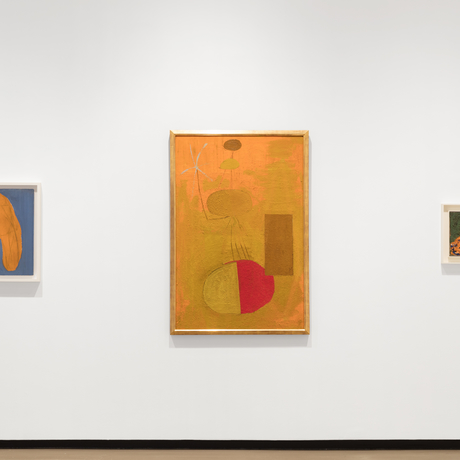

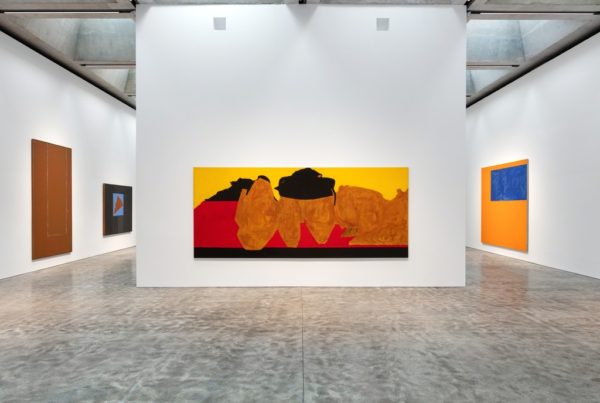
The Motherwell show is easily one of the best of any art walk in Chelsea up now. But it is not the only show of monumental work in the district. There is also Robert Longo’s ferocious “Amerika,” at Metro Pictures, 519 West 24 Street, through May 25. The work, including a stunning Death Star fashioned from bullets, is an investigation into the politics of power, futility, and aggression.
And there is Frank Stella, who has been around New York doing his thing for a very long time.
In 1959, when Stella’s sober “Black Paintings,” with their wide black stripes alternating with unpainted raw lines came out, they shocked the art world. Over the following decades, Stella continued to experiment with line, color, and form with strikingly different effects on canvas and in three dimensions.
Stella’s latest, though not his greatest, ongoing exploration of the spatial relationships between abstract and geometric forms is now up at the Marianne Boesky Galleries, 509 and 507 W. 24th Street, through June 22.
All we can say is this emperor of the art world still shocks. But this time he really is wearing no clothes. Although Stella’s fabricators must have gotten a real workout.
Born in Brooklyn, Lorna Simpson came to prominence in the 1980s with her pioneering approach to conceptual photography. Simpson’s early work raised questions about the nature of representation, identity, gender, race and history and that continue to drive the artist’s expanding and multi-disciplinary practice today. Simpson deftly explores the medium’s relation to memory and history, central themes in her work.

Simpson’s recent, sensuous, somewhat dark (in message) works incorporate appropriated imagery from vintage Jet and Ebony magazines, found photo booth images, and discarded Associated Press photos of natural elements, particularly ice.
Referencing her long practice of merging abstraction and figuration, the monumental glacial scenes are formed using ink and screen prints on gessoed fiberglass. The appropriated frozen vistas against the azure sky and sea echo with a bluesy foreboding, perhaps a metaphor for the disintegrating Antarctic ice shelves, rising sea levels – or the current American political despair, also painted, but with a heavy brush, and on display everyday in the headlines.
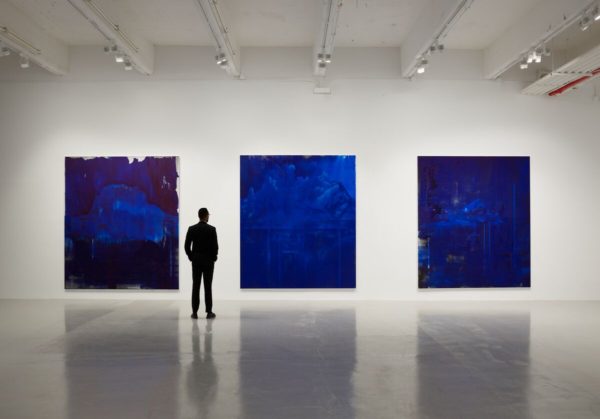
Simpson’s striking new work is now on display at Hauser & Wirth, 548 West 22nd Street, through July 26.
Another fine show in Chelsea features paintings by Joan Mitchell. “I carry my landscapes around with me” is up at David Zwirner, 537 West 20th Street location, through June 22.
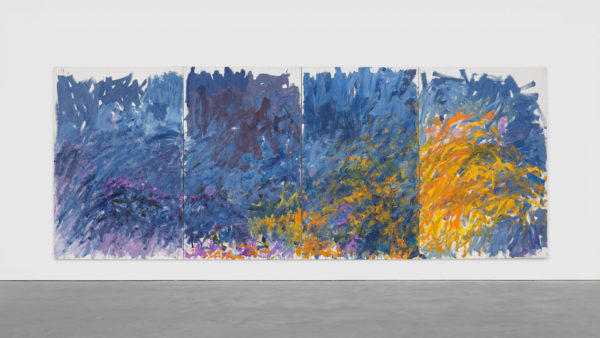
According to the gallery, Mitchell established a singular approach to abstraction over the course of her career. Her inventive reinterpretation of the traditional figure-ground relationship and synesthetic use of color set her apart from her peers, resulting in intuitively constructed and emotionally charged compositions that alternately evoke individuals, observations, places, and points in time.
The horizontally oriented, panoramic expanse of her paintings is ideally suited to landscape, an important and enduring subject for Mitchell that she linked directly to memory.
As the artist stated back in 1958, “My paintings are titled after they are finished. I paint from remembered landscapes that I carry with me—and remembered feelings of them, which of course become transformed. I could certainly never mirror nature. I would like more to paint what it leaves me with.”
The Zwirner show illustrates why Joan Mitchell was such an important figure in the second generation of American Abstract Expressionists. The woman was an ecstatic, uninhibited colorist, who painted her tumultuous feelings onto a canvas.
Other Chelsea stops could include:
Ross Bleckner, Petzel, 456 W 18
Josh Smith, Zwirner, 525 W 19
Walid Raad, Paula Cooper, 521 W 21
Jeff Wall, Gagosian, 522 W 21
Louis Fratino, Sikkema Jenkins, 530 W 22
Sean Scully, Lisson, 504 W 24
Group Show (Serra, Baldessari, Guston, etc), Gemini, 535 W 24
Jonas Wood, Gagosian, 555 W 24
LOWER EAST SIDE: GALLERIES & ICE CREAM
We get by with a little help from our friends.
Earlier in our trip to New York, we visited Matt Kleberg at his studio in the Brooklyn Navy Yard, where he is preparing for a show in September at the aforementioned Gemini Gallery. (Our review of his show in Telluride in 2018 at Ellen Geldbaugh and Katherine Walsh’s On Main pop up gallery is here.)
During that visit, Matt suggested a tour of Lower East Side.

Matt Kleberg in his Brooklyn studio surrounded by new work
MATT SUGGESTIONS:
Marina Adams’ “Anemones” at Salon 94, 243, The Bowery.
Victoria Roth at Brenna & Griffin, 122 Norfolk Street.
Mason Saltarrelli “Incandescent Traveler,” attributing Miro and Klee for two of a number of influences, at Turin Gallery, 37 East 1st Street.
Yevgeniya Baras’s “Seam, Scar, Sign,” at Nicelle Beauchene Gallery, 327 Broome Street.
Shara Hughes’ “In Lieu of Flowers” at Rachel Uffner, 170 Suffolk Street.
Fairfield Porter at Betty Cuningham Gallery, 15 Rivington Street.
At the 2017 Whitney Biennial, we visited the room dedicated to Shara Hughes, whose vividly colored invented landscape paintings were mesmerizing. (Apparently post-biennial, Hughe’s paintings have tripled in auction value.)
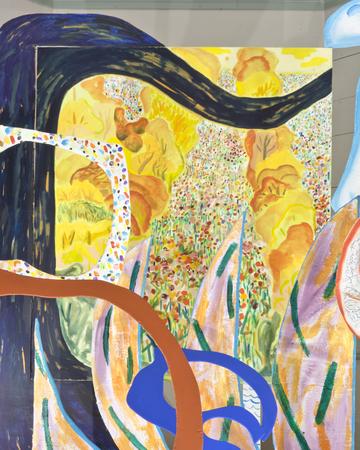
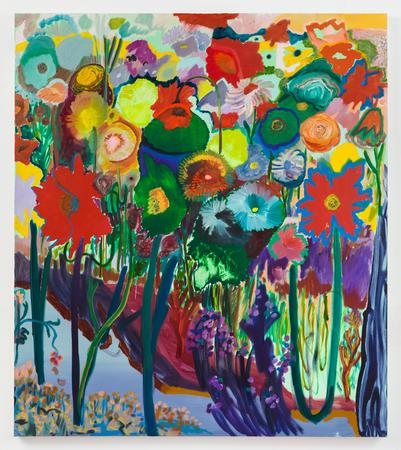
And with good reason.
In this show at Rachel Uffner, Hughes continues to show the wildly imaginative landscapes that have defined her practice for the past four years. The works are clearly informed by Hughes’ deep-seated knowledge of art history: the artist quotes Van Gogh, O’Keefe and the vanitas tradition to name a few influences.
We found Hughes’ paintings as vibrant and engaging as they are visionary, her mindscapes windows into disturbed worlds, often filled with stuff that is dying.
Our world?
Like Simpson’s lyrical, yet muscular images, Hughes masks political commentary, seducing with compelling works that belie what we believe to be a plausible subtext.
A jewel of exhibition of paintings and works on paper by Fairfield Porter (1907-1975),”Amherst and Other Places,” is now up at the Betty Cuningham Gallery, through May 24.
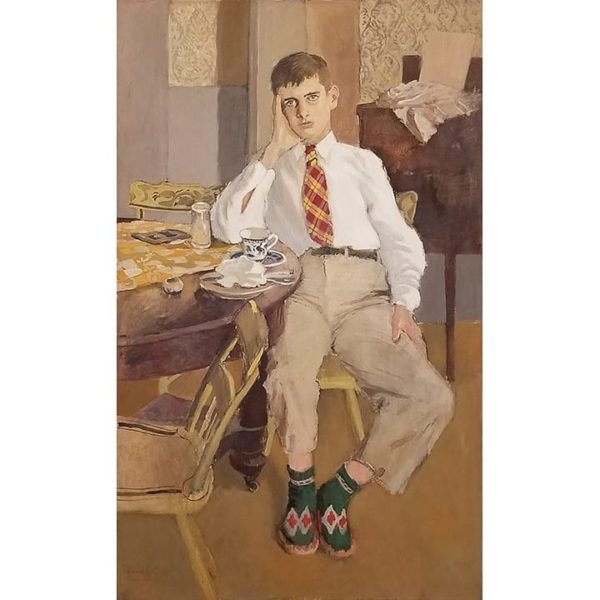
The show features eight small oil studies that have never been exhibited. The work was completed in 1969-70 when Porter was teaching at Amherst College. The exhibition includes a major portrait of the artist’s son Jerry, and a painting of the Porter family home on South Main Street, in Southampton, NY.
Having shown his work in New York since 1952, Porter quickly rose to prominence both as a painter and as a critic. He insisted his subject was the painting, not the image itself, choosing the ordinary views before him: a breakfast table, a screened porch, a driveway or informal portraits of family and friends.
Porter’s choice to paint what was in front of him led to a sparring relationship with the rock star critic Clement Greenberg. Of their relationship, Porter wrote:
“We always argued. We always disagreed. Everything that one of us said, the other would say no to it. He told me I was very conceited. I thought my opinions were as good as his or better. And, he once said – I introduced him to de Kooning – he was publicizing Pollock and he said to de Kooning (he was painting the Women), ‘You can’t paint this way nowadays.’ And, I thought, ‘Who the hell is he to say that?’ He said, ‘You can’t paint figuratively today.’ … I thought, ‘If that’s what he says, I think I will do just exactly what he says I can’t do! That’s all I will do.’ I might have become an abstract painter except for that.”
Our last stop – which Matt deemed mandatory – was Morgenstern’s, where each scoop of ice cream is a work of art.
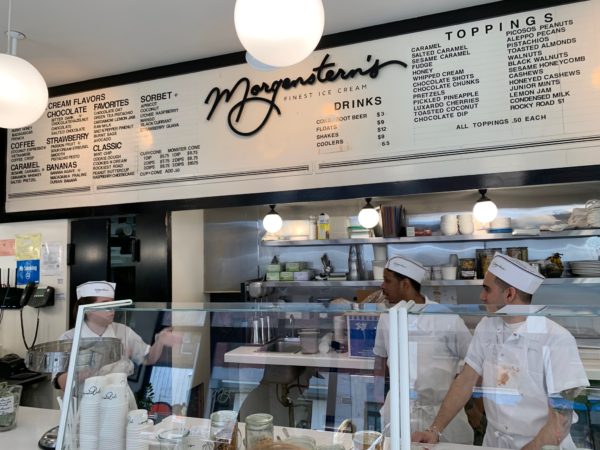
According to Morgensterns’ website, Nicholas Morgenstern is a self-made restaurateur, with extensive pastry experience in some of New York’s finest establishments. In 2014, he opened Morgenstern’s Finest Ice Cream.
“Morgenstern’s Finest Ice Cream is my chance to express my love of the quintessential American indulgence. I have been dreaming of these flavors, this style, and this place for years.”
We will be dreaming of that stop for years.
MORONI AT THE FRICK:
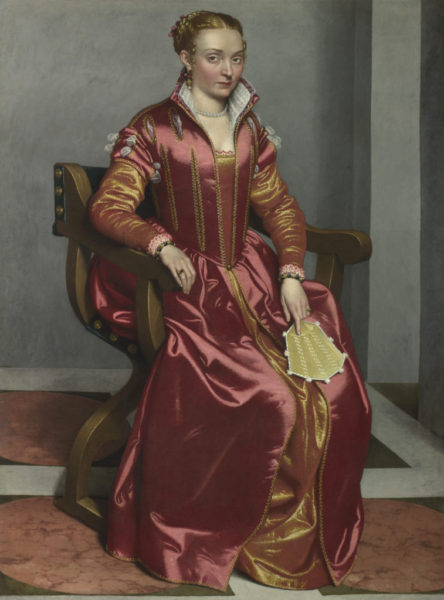
According to the Museum:
Moroni: The Riches of Renaissance Portraiture is the first major exhibition in the United States to focus on the portraiture of Giovanni Battista Moroni (1520/24–1579/80). A painter of portraits and religious subjects, Moroni is celebrated as an essential figure in the northern Italian tradition of naturalistic painting that includes Leonardo da Vinci, the Carracci, and Caravaggio. This exhibition, shown exclusively at The Frick Collection, brings to light the innovation of the artist, whose role in a larger history of European portraiture has yet to be fully explored. His famous Tailor (National Gallery, London), for example, anticipates by decades the “narrative” portraits of Rembrandt, and his Pace Rivola Spini(Accademia Carrara, Bergamo), arguably the first independent full-length portrait of a standing woman produced in Italy, prefigures the many women that Van Dyck would paint in this format in the following century.
The Frick presents about twenty of the artist’s most arresting portraits together with a selection of complementary objects — jewelry, textiles, armor, and other luxury items — that evoke the material world of the artist and his sitters and reveal his inventiveness in translating it into paint…
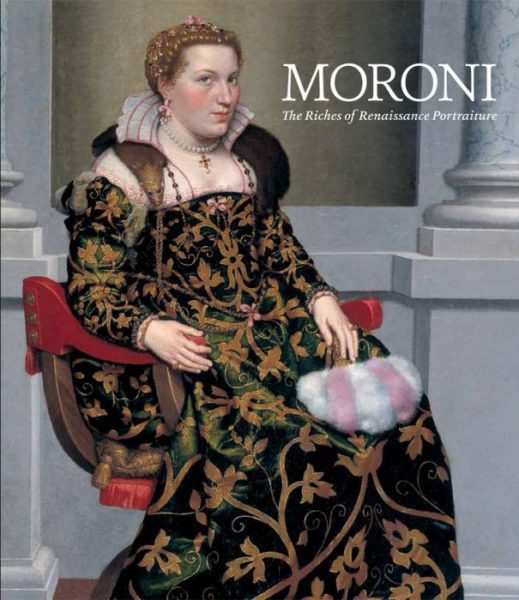
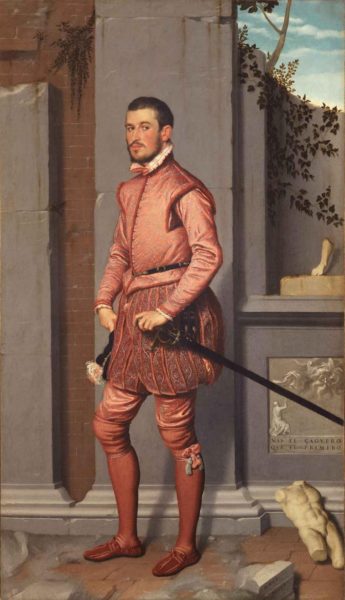
The Moroni show is a revelation simply because the Renaissance master has never been painted? tainted? by celebrity. His naturalistic portraits seems to be what he saw is what we get. Moroni’s people feel familiar – even if they are tricked out in very elaborate threads. The artist hits the bullseye every time, revealing the inner life of each and everyone of the 23 sitters in this tribute show. Their direct gazes penetrate our souls.
‘TOOTSIE” OR BROAD HUMOR ON BROADWAY:
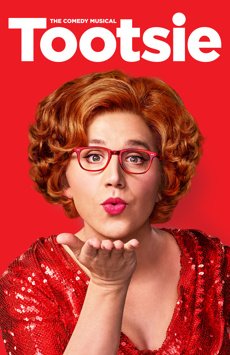
“Tootsie” first came to life on screen and into pop culture in 1982 as a smash hit comedy about what once upon a time was ultimate transformation. (Now, meh, unless someone is trying to use the “wrong” public bathroom.)
The plot follows a self-centered stage actor named Michael Dorsey, Tony award nominee Santino Fontana, who finds the success he craves by posing as a smart, feisty actress named Dorothy Michaels. Mayhem and hilarity ensue. The irresistible story needed to be set to music and now “Tootsie” is up at Broadway’s Marquis Theatre with a star-making performance by Fontana in the role that used to rhyme with Dustin Hoffman.
“She’s so friggin’ sexy / And so friggin’ smart / She’s made me an actor / She’s built like a tractor…”
“Faye Dunaway as a gym coach…”
“Don’t hold your nose / I won’t decompose / I smell like a rose / I’m alive.”
“At a time when women are literally clutching their power back from between the legs of men, you have the audacity to take a job away from one by perpetrating one?… You’re pretending to be a woman to get a job! And you know you’ll have to take a pay cut.”
Those are just a very few of the nonstop comedic lines from a reincarnated “Tootsie.”

“Tootsie” starspower.
“The most glorious words in the English language, the director of the show-within-a-show in 42nd Street once declared, are musical comedy. But few musicals on Broadway these days live up to the second part of that term: They evoke fond chuckles of appreciation, but they don’t suck the laughs from your belly. Enter Tootsie, all dolled up in a red sequined gown, to drag out the real comic goods. Let other shows mope or brood or inspire, as some of them do very well. This one is out to give you a good time, and that’s just what it does. Tootsie rocks. Tootsie rolls. Tootsie pops,” raved Adam Feldman, Time Out New York.
“The ace creative team of writer Robert Horn, composer-lyricist David Yazbek and director Scott Ellis respect the footprint of the movie. But the explosions of laughter the musical elicits come chiefly from the ingenious ways in which the screenplay by Larry Gelbart and Murray Shisgal – plus the countless other hired hands that took a pass during the film’s famously difficult conception – has been reimagined as a subversive comedy about gender roles specifically tailored for our times. And no, don’t roll your eyes and wince about another gem from a less enlightened decade sacrificing its luster to anxious PC tampering. This is a savvy update that manages to combine awareness of the evolution in gender politics with insouciant wit, a playful spirit and an invigorating streak of good-natured vulgarity,” David Rooney, The Hollywood Reporter.
“Robert Horn (book) and Tony-winner David Yazbek (score) have a high old time poking fun at theatrical rituals – the mortifying auditions, the grueling rehearsals, the agonizing openings, the backstage heartbreak – in this affectionate sendup of a Broadway musical (replacing the movie’s soap opera setting) and its uniquely unlikely star. Director Scott Ellis leaves nothing and no one unscathed in staging this satire of a Broadway-bound musical called ‘Juliet’s Nurse.’ From the gaudy Renaissance costumes (by William Ivey Long) to the over-the-top choreography (from Denis Jones), the creatives nail it,” said Marilyn Stasio of Variety.
Our take? “Tootsie” is musical comedy heaven – hitting it harder on the “comedy” bit. The music, while good, is not “Guys & Dolls” – more guys as dolls. That is to say, you don’t leave the theatre humming the tunes. But you will leave laughing. If there are any runs in the show’s stockings, it is the woke parts. Revelations about how tough it is to be a woman seem, at times, to have been shoehorned in for the #MeToo crowd. Then again, some of those feminist tropes work. But not as hard as the cast which is pitch perfect. Fontana, who has to walk a mile in those heels, even pulls off a distinctive singing voice for his Dorothy, a downy contralto. And the choreography is some of best you will ever see on or off the Great White Way. “Tootsie” is all guts, grit and girdles. Go!


Sorry, the comment form is closed at this time.